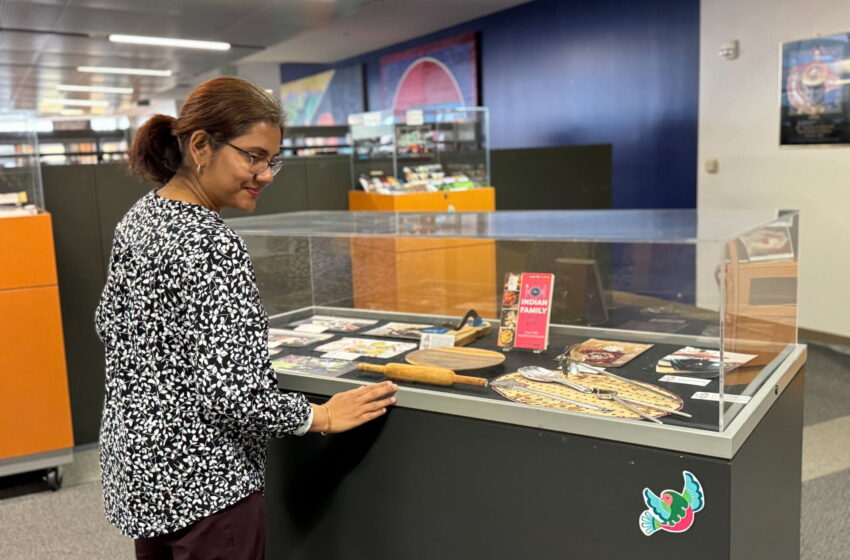San Jose State University showcases South Asian diaspora

SJSU Librarian Mantra Roy checks on one of the exhibit cases that displays cooking utensils used across South Asia. Photo: Lesley Seacrist.
South Asians comprise almost 20% of the Bay Area’s population, but their stories are rarely told. For the first time, San Jose State University King Library is showcasing the vibrant tapestry of the South Asian diaspora in a new exhibit “South Asians in Silicon Valley.”
From intricately crafted artifacts to evocative photographs capturing moments of everyday life, each artifact tells a story — a testament to the resilience, creativity and diversity of South Asian communities from Afghanistan, Bangladesh, Bhutan, India, Nepal, Pakistan and Sri Lanka.
READ: ‘Beyond Bollywood’ in Seattle: Exhibition traces centuries old Indian immigration to America (November 10, 2019)
Since libraries serve as repositories of knowledge, the Africana, Asian American, Chicano, and Native American (AAACNA) Studies Center, SJSU Collection Strategy Librarian Mantra Roy saw an opportunity to showcase the rich traditions, customs and histories of the South Asian diaspora.
Through her exhibit, Roy seeks to educate, connect and celebrate the multifaceted identities of South Asians with the strong belief that the power of culture will unite, inspire, and transform lives. The SJSU King Library is hosting the “South Asians in Silicon Valley” exhibit reception on April 27, from 2–4 p.m.
The “South Asians in Silicon Valley” program will represent and showcase different aspects of the South Asian experience in Silicon Valley, or the larger Bay Area, according to Roy. The diasporas from these countries continue to cultivate their national cultures and traditions within their community spaces, she told the SJSU News Center.
READ: Balbir Singh Sodhi’s turban on mannequin at Smithsonian exhibition reminder of discrimination community has faced (February 26, 2014)
The “South Asians in Silicon Valley” program will be the first opportunity for all of them to showcase, share and educate attendees and each other about their unique and shared cultures through a publicly accessible space, the SJSU King Library.
Asked how the program will benefit SJSU and the local community, Roy said it will bring visibility to the lived experiences of the diasporas of South Asians in the wider Bay Area.
“Community members will experience acknowledgment of their contributions and impact because in spite of their numbers, very little is on record and publicly visible in public spaces such as libraries,” she said.
Students and faculty of SJSU will gain the opportunity to study the rich complex South Asian diaspora from multiple perspectives, such as food habits, religious practices, music, entrepreneurship and more, Roy said. Faculty associated with the Ethnic Studies mandate for CSUs will find many opportunities to develop curriculum around these library programs, she added.
Asked why is it important for South Asian communities to be recognized for their contributions, Roy said, “The less we know of each other, the more biases persist. While the names of some South Asian tech sector leaders are well known in Silicon Valley, or the larger Bay Area, there are multiple sectors and various capacities in which the diasporas contribute, enrich and diversify the valley that are lesser known.”
“On one hand, the South Asian communities thrive in their respective communal spaces that often end up being cultural silos,” Roy said. “On the other hand, there are stereotypical images of these communities that circulate in mainstream media and perception.”
“For example, unless someone is interested in Indian classical dance forms, they wouldn’t perhaps know that there are several schools/academies offering lessons in these forms for at least 50 years in the Bay Area,” Roy said. “But many people would identify ‘Bollywood’ as a popular label for all South Asian music and dance forms.”
Roy said she was including all seven South Asian neighboring countries in this project as they all — Afghanistan, Bangladesh, Bhutan, India, Nepal, Pakistan and Sri Lanka — share historical, cultural and ethnic similarities because they formed a continuous geo-cultural entity before today’s political borders emerged through the experience of European colonialism.
“I believe that the ‘South Asians in Silicon Valley’ program will highlight both these similarities and shared traditions and the unique direction each country has followed over the last few centuries,” she said.
Community-engaged projects such as the “South Asians in Silicon Valley” program help librarians implement inclusion practices and create spaces for previously underrepresented stories, Roy said.
Such projects make belonging in institutional records possible, she said. “Librarians create programs to explore and showcase multiple aspects of a community and build collections to enhance knowledge about the community.”

